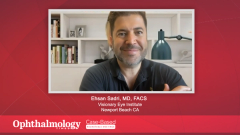
Impressions and take away points from patient Case #1
A minimally invasive glaucoma surgery specialist discusses impressions and key take away points from patient case and how minimally invasive glaucoma surgery has changed the landscape of open angle glaucoma.
Ehsan Sadri, MD, FACS: In this case, you can see he had a nice, improved vision, in addition to intraocular pressure. In the old days, not too long ago, I would say 10 years ago, we would do bilateral trabeculectomies on this type of patient with or without cataract extraction surgery. But with the advent of minimally invasive glaucoma surgeries [MIGS], we’re very fortunate to be able to provide this patient a minimally invasive treatment with minimal downtime. As you remember, the trabeculectomies were challenging, to say the least. For those of us who cut our teeth doing them while we were doing fellowship, you never really knew what you were going to get. The next day was almost like a crackerjack box, the surgery could have gone great, but postoperatively the pressure could be way too low, or way too high, and these patients often needed either laser suture lysis or needling. These types of procedures are still done in my practice, but they’re more of a tertiary refractive glaucoma.
Thank God for MIGS in general, we’ve been able to offer patients rapid recovery procedures, and this is my go-to start procedure now for all my patients with glaucoma. I tell my patients that we’re going to go ahead and start with the minimally invasive treatments, and if that fails, then we’ll progressively get to the more invasive treatments, and patients appreciate that. The other question that came up when I was presenting this is what kind of lens implant would you do? Would you do the EDOF [extended depth of focus] lenses? Would you do multifocal lenses? Certainly, I would not do any multifocal lenses or any diffractive optics because I worry about contrast loss in a patient like this, who’s still a practicing physician. I think it’s really important to emphasize intraocular pressure reduction with a patient and make sure that they understand the why of what we’re doing because they need to understand the challenges and realities of how glaucoma progresses.
I tell patients this is not going to cure your glaucoma, this is going to allow us to slow it down. And I use an analogy like arthritis. I tell them a patient can essentially present similar to arthritis, and we don’t cure it, we slow it down. We still have to maintain a really close watch because I’m worried about his visual field functionality. If you read the literature, the AGIS study shows that with lower intraocular pressure and a decrease of the peaks and troughs, you’ll do better, but there’s no guarantee. And I always leave that door open, especially for physicians, because they need to know the limitations of technology.
The other important pearl here is that with these types of MIGS procedures, for me and my practice, it’s been really nice because it gives the patient a nice quality of life. When I did trabeculectomies, the patients’ quality of life would decrease, and we did studies on that. We studied patients when I was a fellow and afterward, and I published this, looking at the quality of life measurements, both by history and also surgery. In other words, we know from our studies that when you tell a patient, "It appears you have glaucoma," their quality of life from a mental status decreases. This has been well studied in the literature. In addition to trabeculectomy, post-operative outcomes measurement shows that patients have all sorts of issues when it comes to a lower quality of life, because it usually means that the patient would have to go see the physician over and over again. And it was a true partnership. I’m very excited in light of this era because we’re able to offer our patients less invasive and higher quality procedures.
I’m often asked what the MIGS treatment options are for patients. So, a little background, when I was a fellow at UC [University of California] Irvine, I was the first American clinical fellow, prior to that they had an international program. A little history, I was fortunate enough to meet and discuss a possible fellowship with the late George Baerveldt, MD, who’s the namesake of the Baerveldt shunt, and he was the chair at UC Irvine. When I entered the fellowship, it was very busy because there was just myself and 2 really busy practicing surgeons. It was Richard Hill, MD, and Dr Baerveldt. As a fellow, I would see and do surgeries on both of their patients, and it was probably 10 to 15 trabeculectomies a week, which is really busy. And as we talked about, the trabeculectomies were problematic because the patients’ outcomes were very variable, and the morbidity of the surgery was quite high. The quality of life measurements show that the patients’ quality of life was low.
When I was a fellow, I kept thinking, “There’s got to be a better way, this is ridiculous, the fact that a patient has to come back, and come back, and come back, and we don’t know what’s going on.” It was problematic for the surgeon and for the patient. One night probably about 4 months into my fellowship, I pulled my mentor Dr Hill over and said, “Look, there’s got to be a better way. There’s got to be almost like a cardiac stent, something we’ve got to do for these patients.” And he smiled and was very pensive, an extremely smart surgeon, mentor of mine. We went over, I think was 9 PM, behind the parking lot, and he brought me the plans for his stent that he had designed, which ultimately became a company and now is publicly traded, called Glaukos. That’s kind of the funny personal background on it.
The stent was an idea of what happens in cardiac surgery. The thing about cardiac surgery is you do 2-, 3-, 4-, 5-vessel surgery. The surgeon has to crack the chest open; it’s very invasive, extremely problematic, and a high morbidity and mortality rate. The same was true for glaucoma surgeries; we had nothing that was ab interno or minimally invasive. We had looked at different options, but we really didn’t have any good stent options. So in comes the iStent generation 1, which I designed with him, and he ultimately basically retired and became a full-time researcher. But the impact that the original iStent had on the patients was absolutely remarkable. I was very fortunate to spend time with him and learn about the venture, learn that we can change things as a physician, from an outcomes and design standpoint.
What are the MIGS options today? There are plenty of different technologies way beyond the scope of what we’re going to be talking about today. But I would categorize them as bleb-based surgeries, so the XEN gel stentprocedure, which is Allergan Inc, an Abbvie company, essentially is external, still you have to create a bleb, designed and FDA approved for refractory glaucomas. Obviously, we have the glaucoma shunt devices still around, the Ahmed valve and the Baerveldt valve….
Moving into the eye, ab interno procedures, we can categorize them as trabeculectomy and goniotomy procedures. The goniotomy procedures, each of the companies mentioned have essentially entered the market in the last 24 to 48 months to capitalize on the minimally invasive procedure, and No. 2, the favorable reimbursement codes that have historically been good. Although it remains to be seen how long that will last. But I want to give you an overview of what the MIGS procedures are, and I think everybody is going to have to try different ones. The scope of this talk is going to be an overview of the MIGS, but there are several options, and you can ask your local representative to educate you on the different options.
One of the more popular MIGS procedures is what is now typically called in layman’s terms the OMNI procedure, or the OMNIdevice. Sight Sciences, Inc produces OMNI; I am a consultant for them. The device is designed to essentially enter the trabecular meshwork and also cannulate and do a trabeculectomy; it’s an elegant design, very minimally invasive. You still have to rotate the head of the patient to visualize the angle, as you do with all MIGS procedures. But it lends itself nicely because I think the biggest positive point for this procedure is that we don’t leave a device behind. The data on it are pretty remarkable.
The other major advantage of this device among the other procedures, including goniotomies, is that it’s reproducible. In other words, you can redo the procedure as a standalone, so it’s not tied with cataract extraction surgery, whereas your traditional device-based MIGS procedures are. If a patient comes in who is pseudophakic and has multiple glaucoma drops, it’s a good opportunity for them to get this device.
Transcript Edited for Clarity
Newsletter
Don’t miss out—get Ophthalmology Times updates on the latest clinical advancements and expert interviews, straight to your inbox.

















































.png)


